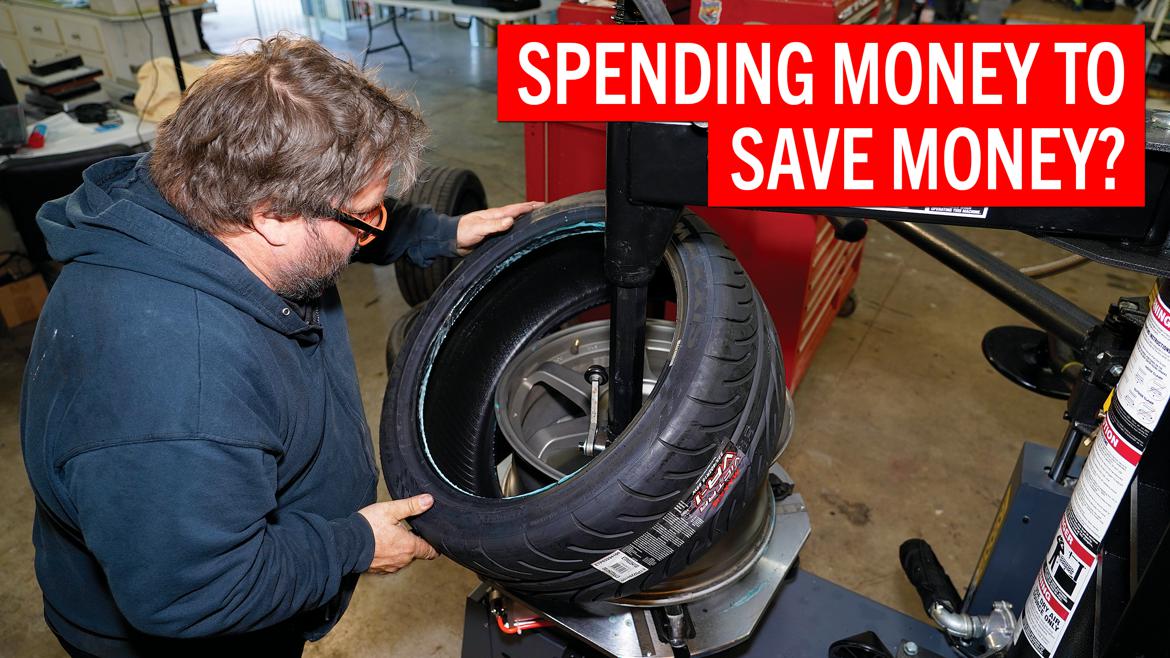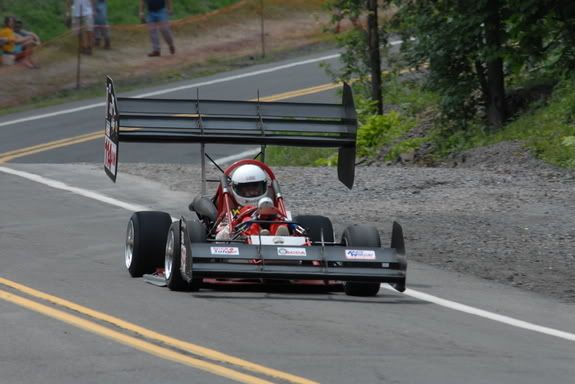I am new to this forum but I have been reading GRM since 2008. What I don't understand is why wings are attached on Solo/ slalom cars. I am an aircraft engineer and have worked with a pro Formula Atlantic team and wings really only start working at 70 mph! The weight would be negative and down force is so minimal. Wings really are effective at 100 mph and above. The time dialing in mechanical grip would be much better than a wing could ever achieve. That is of course if slalom cars do hit 100 mph on the corners. What do I know ; I have only worked on open wheel cars and never slalomed a car. Someone who has really improved their time through wings please educate me. I have been wrong before and I know some day I will be wrong again!
Tugiaou
If wings start working at 70mph, explain an Alaska bush plane's stall speed 
In all seriousness, if you're an aircraft engineer, I figure you've forgotten more about aerodynamics than I'll ever know, but given what is known about solo wings, I assume you simply aren't considering what a wing tailored to low-speed applications can do.
Just googling autocross or solo aero should get you some results, but this being the GRM forums, someone with firsthand experience should be along shortly...
If you've been reading since 2008... I'm trying to recall whether there was testing data along with the new wings built for Per's B Mod LeGrand... Hrm, doesn't look like it. Several iterations of wing construction, but no downforce numbers.
Here's a previous discussion on the forum.

Per Schroeder
Technical Editor/Advertising Director
6/28/12 8:08 p.m.
I used that E423 airfoil because I had seen some good numbers from an FSAE test--I'll look for it in the AM.
I'm not an expert in the field, but have some fluid mechanics background and can shed some light on the fundamentals behind this:
F_L = C_L * 1/2 * rho * A_surface * V^2
at AoA = 12 degrees: C_L = ~2.07 (for something like the S1223 profile)
rho = ~1.1 kg/m^3
A_surface (reflected surface area) = ~0.7 m^2
V = 60 mile/hr = ~26.8 m/s
F_L (lift force) = 1144 N = ~ 257 lbf
So, you can generate over 250 lb of downforce with a reasonably sized wing at 60 mph. We built a wing like this for the Wreck Racing car (really for track racing, not auto-x, but still applies), and it only weighed 17 lbs. Would have been much less if it were carbon fiber or thin Al and designed only for auto-x loads.
The trick is selecting an airfoil profile designed for very low Reynolds number operation. They are pretty dramatically different compared with high-Reynolds number aircraft wings and would have way too much drag at high-speed to be useful.
If you're interested in this airfol specifically, here's some more data:
http://www.worldofkrauss.com/foils/701
It's used a lot for heavy-lift competitions where obtaining extremely high lift at low speed is the goal. It's very similar to the E423, but has a wider range of useful AoA and a slightly lower peak C_L.
Here's the E423:
http://www.worldofkrauss.com/foils/560
Also, for reference the 0.7 m^2 for the wing area comes from a 77in span, 14in chord design.

admc58
Reader
6/28/12 10:05 p.m.
Bob Tunnel told me that the wing on his heavily modified M3 was worth at least 3/10ths of a second on a 60sec autox course and Yes he has tested it back to back with/without the wing.
I like to think of it as you are driving a traction limited automobile and ANY additional down-force will allow getting on the throttle earlier & harder.
The Modified drivers call it "flying the wing"...the faster they go the faster they can go...to a point.
admc58 wrote:
The Modified drivers call it "flying the wing"...the faster they go the faster they can go...to a point.
This raises and interesting point that maybe some of the math wizards can help me with. I don't know much about exactly how aerodynamic force scales with speed related to how slip angle scales with speed for a given radius. But would it be possible to create a configuration such that a car would not be able to negotiate a given corner at speed x, but due to additional downforce the same car would be able to negotiate the corner at speed >x. Basically, is there ever a point where the additional aero force curve is steeper than the additional slip angle curve?
jg
Wings work at VERY low speeds. Sailboat sails are not parachutes, well, except for spinnakers. They are wings and they are efficient at 2mph.
I can testify that wings on solo cars work at lower speeds. I've driven the B-Mod LeGrand Dragon of Tommy Saunders. It's got a flat bottom, splitter, diffuser and front and rear multi element wings. The wings on that car work at speeds of 30-ish mph.
Wings can be made to be efficient at whatever speed you design them for. Where wings don't work is when you try to make them work at a huge range of speed. When they well at 20mph, they don't work so well at 120mph. But many solo cars spend most of their time in a 30mph window. The stockers are going between 20-50 and the mod cars are going 35-70.

In reply to JG Pasterjak:
Very interesting question. The downforce increases as velocity squared:
F_L = C_L * 1/2 * rho * A_surface * V^2
Assuming the coefficient of friction of the tires did not decrease as additional vertical load (downforce) was applied that would mean that the cornering force available would also increase with velocity squared.
The centripetal force required to accelerate a vehicle with mass M and tangential velocity V around a corner with radius R would be:
F = M * V^2 / R
The centripetal force also scales as velocity squared, so in theory both forces increase at the same rate and if you were on the limit of traction at speed V, you would also be at the limit at speed >V or <V.
However, since the coefficient of friction of the tires decreases with more vertical load, you see diminishing returns for higher and higher downforce and you can't just keep taking a corner faster and faster.
This also assumes that your wing or whatever aero features you have on the car have the same efficiency at any speed, which is not the case.
Dunno about all the math, but from practical experience: wings on the rear of an R/C car are essential. Stick your hand out the car window at 20 MPH, start flat, then tilt into the airflow and see how much force is generated. That's a very crude demonstration of just how much a supposed slow speed can generate significant downforce.
The wings on the BBR Shark (top car in Joey's hotlinks) were designed in a wind tunnel.
Wow, I think I sort of understand that. ^^^
I'm not sure I understand how CoF decreases with vertical load though. I'd always though the point of diminishing returns with downforce was when it overheated the tires? Or is what you are referring to?
From my very limited knowledge of wing profile design, wings which are designed for lift at lower speeds can become inefficient at higher speeds. So I would think that as the speed increased over such a profile, at some point the lift (or downforce) would decrease. But I am probably dead wrong. 
OK, so here's my question. Let's say you have a 3,600-pound, depleted-uranium land yacht powered by a V8. Is there any benefit at all of installing aero for autoX, or should I only be concerned about high-speed aero for road courses? And will a wing that provides good downforce on the main straight at Summit Point do anything for me on an autoX course?
If it's an adjustable wing and you adjust it to its maximum downforce/speedbrake position for autocross and to an airfoil position for road course work.

Ian F
UberDork
6/29/12 9:19 a.m.
vern2point3 wrote:
If it's an adjustable wing and you adjust it to its maximum downforce/speedbrake position for autocross and to an airfoil position for road course work.
To a point. Look at open wheel F1 and Indy cars. They use completely different aero packages for high speed and low speeds tracks. I understand that's part of what makes Indy (the race) so difficult. They are trying to balance the set-up on a razor's edge between down force and aero drag. Too much drag and you're slow. Too little down force and you're into the wall at 200 mph...
Angle of incidence comes in here too.
Many single element wings are run at "stall" which is some where around 13 degrees in most cases.
Now sprint cars are a whole differnt ballgame.

Jaynen
Reader
6/29/12 10:10 a.m.
JG Pasterjak wrote:
admc58 wrote:
The Modified drivers call it "flying the wing"...the faster they go the faster they can go...to a point.
This raises and interesting point that maybe some of the math wizards can help me with. I don't know much about exactly how aerodynamic force scales with speed related to how slip angle scales with speed for a given radius. But would it be possible to create a configuration such that a car would not be able to negotiate a given corner at speed x, but due to additional downforce the same car would be able to negotiate the corner at speed >x. Basically, is there ever a point where the additional aero force curve is steeper than the additional slip angle curve?
jg
Completely uneducated answer but the in the episode of Top Gear UK where Richard Hammond got to drive the F1 car he stated that very problem as one of the things that made the car so hard to drive. He was not capable of driving it fast enough to make the aero work well enough for him to go faster

Ian F
UberDork
6/29/12 10:32 a.m.
Jaynen wrote:
Completely uneducated answer but the in the episode of Top Gear UK where Richard Hammond got to drive the F1 car he stated that very problem as one of the things that made the car so hard to drive. He was not capable of driving it fast enough to make the aero work well enough for him to go faster
In my single, sloppy auto-x run in a F-Mod car (which has no aero), I can understand this. It's incredible how fast everything happens in a purpose-built, open wheel race car.

Per Schroeder
Technical Editor/Advertising Director
6/29/12 10:40 a.m.
Yea, I found number that were in the low to mid 200s at 60mph for the E423, but none with the multiple tiered set-up that I have now. You can generalize from some data on flaps and slats that Simon McBeath has in his book/writing that I'm adding another 30 percent or more.
Short answer, it's very helpful on a 780lb rocket.
Per
Sky_Render wrote:
OK, so here's my question. Let's say you have a 3,600-pound, depleted-uranium land yacht powered by a V8. Is there any benefit at all of installing aero for autoX, or should I only be concerned about high-speed aero for road courses? And will a wing that provides good downforce on the main straight at Summit Point do anything for me on an autoX course?
You may be interested in this. Or even the entire thread.
http://www.roadraceautox.com/showthread.php?p=1061627#post1061627














































